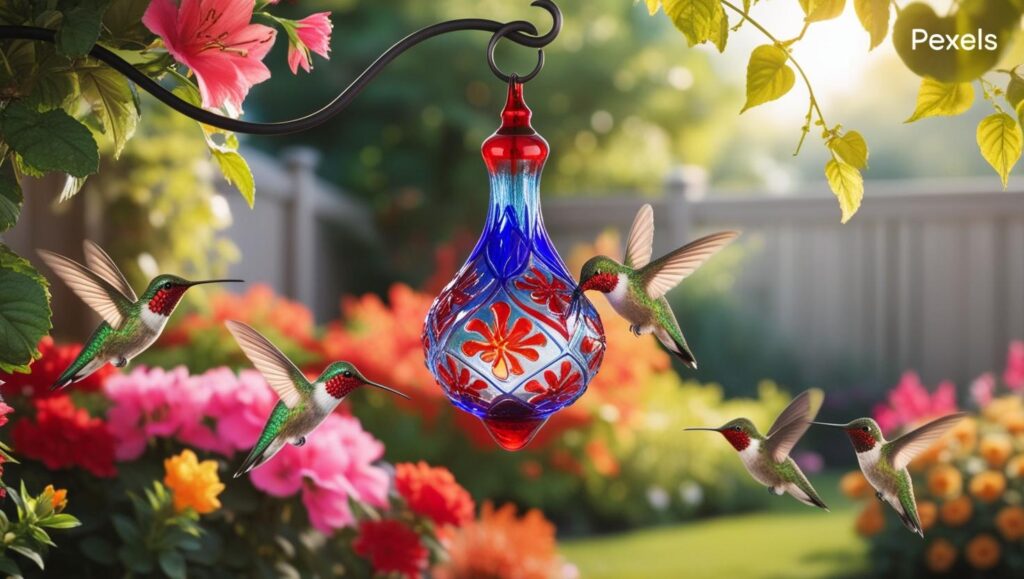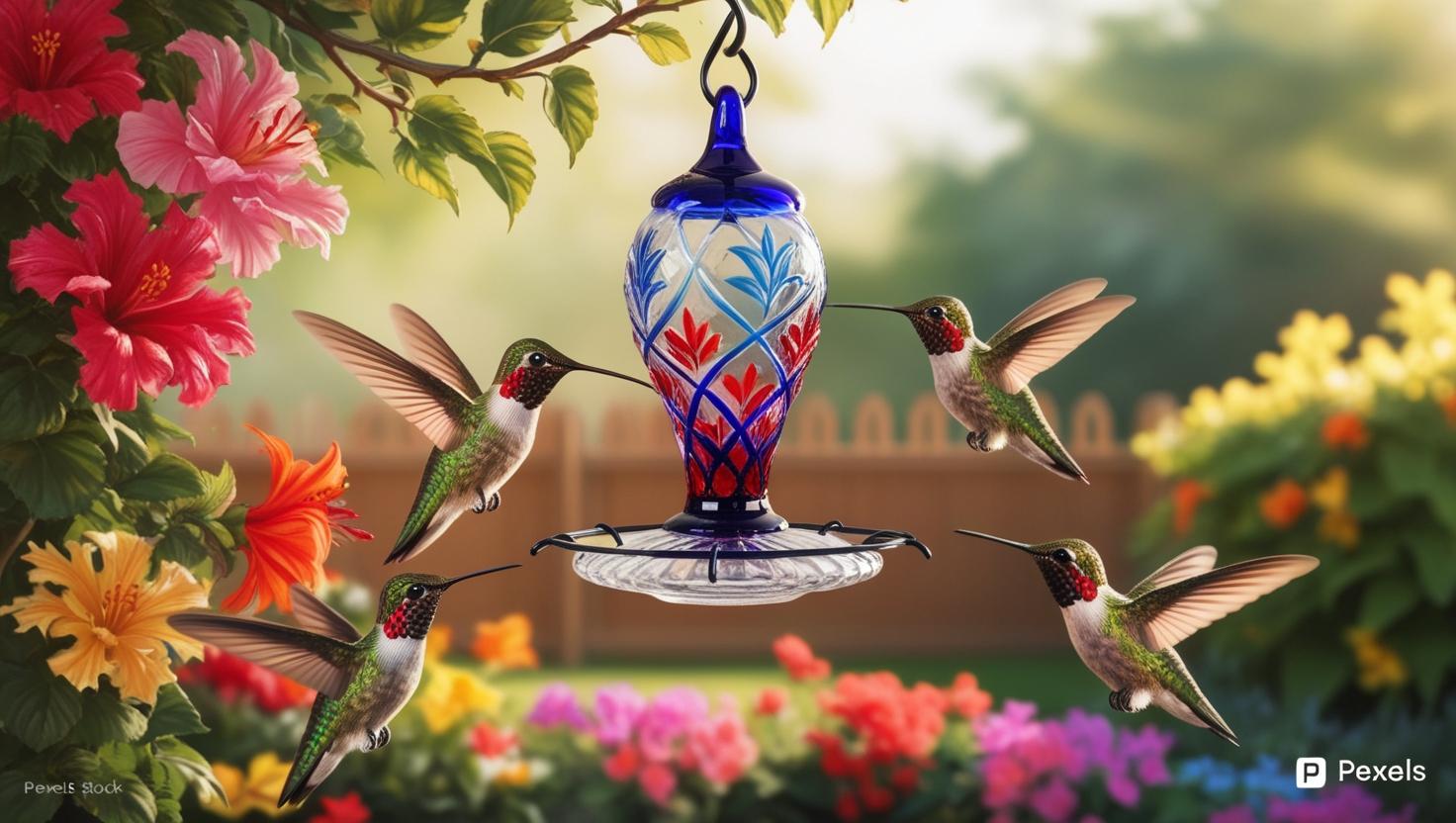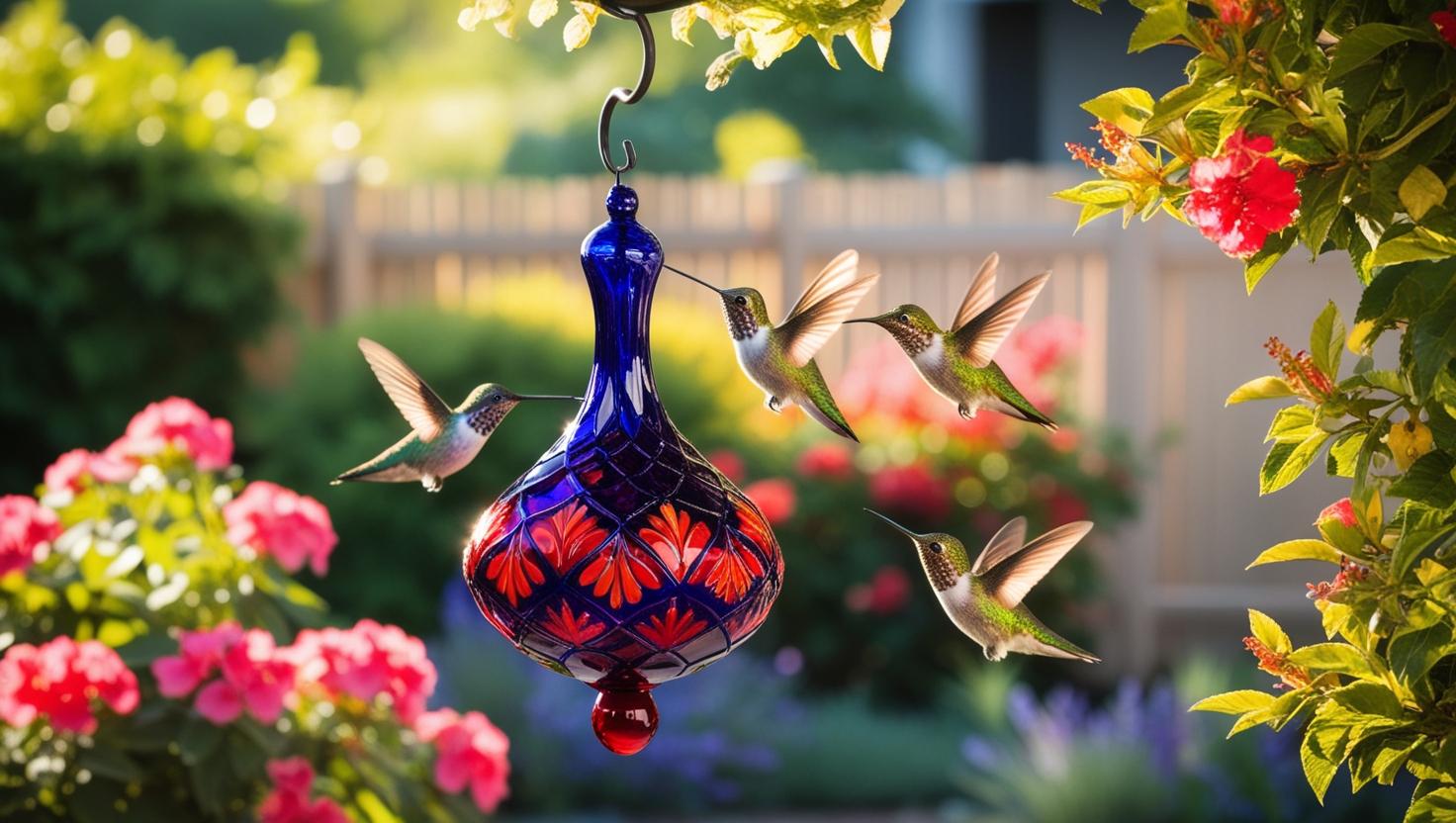When it comes to enhancing the look of your outdoor space and attracting delightful winged visitors, few items are as enchanting as a blown glass hummingbird feeder. This exquisite garden feature is not only a functional device for nourishing hummingbirds but also a piece of art that adds a vibrant, decorative flair to your surroundings. Beyond its aesthetic appeal, a hand painted hummingbird feeder can offer numerous benefits—from enticing more hummingbirds into your yard to creating a focal point that delights both you and your guests.
In this article, we’ll delve deep into the features, benefits, and reasons why investing in a blown glass hummingbird feeder—especially a beautifully hand painted one—can transform your outdoor garden into a haven of natural beauty. Additionally, we’ll look at related concepts like decorative hummingbird feeders, their uses, and tips for maintaining and displaying them, ensuring that you get the most out of your investment.
The Artistry of a Hand Painted Hummingbird Feeder
A hand painted hummingbird feeder stands apart from mass-produced, factory-finished models thanks to its attention to detail and craftsmanship. Skilled artisans meticulously shape and color the glass, infusing it with intricate designs that often feature natural motifs—think floral patterns, swirling leaves, or brilliant sunset hues. This careful hand-painting process ensures that every piece is truly unique, turning each feeder into a functional work of art.
Key Features of Hand Painted Blown Glass Hummingbird Feeders:
- Distinctive Aesthetics: The use of vibrant colors, organic shapes, and hand-applied patterns create a visually captivating object. Such decorative hummingbird feeders bring an immediate sense of elegance and refinement to any garden setting.
- High-Quality Materials: Because these feeders are often crafted from robust, durable glass and treated with weather-resistant paints, they are well-suited for long-term outdoor use. A glass hummingbird feeder for outdoors is built to withstand sunlight, rain, and wind, ensuring that your investment stands the test of time.
- Easy to Use and Maintain: Most blown glass hummingbird feeders for outdoors feature removable bases and wide-mouth openings that simplify filling and cleaning. Proper maintenance helps keep your feeder safe and hygienic for your feathered friends, minimizing the risk of mold or bacterial growth.
Why Choose a Blown Glass Hummingbird Feeder Over Other Materials?
When selecting the ideal hummingbird feeder, you’ll find a wide range of options—plastic, metal, ceramic, and glass. However, a blown glass hummingbird feeder consistently outshines the competition in several key areas:
- Durability and Longevity: High-quality glass feeders are less likely to warp or degrade in the sun compared to plastic options. They maintain their shape, clarity, and vibrant coloration even after prolonged exposure, ensuring a beautiful and functional garden accessory for years to come.
- Non-Toxic and Safe Materials: Glass is an inert material, meaning it won’t leach harmful chemicals into the nectar. Additionally, glass is easy to sanitize, which keeps the feeder—and the hummingbirds—safer and healthier.
- Enhanced Visibility for Birds: The transparent or translucent design of a glass feeder makes it easy for hummingbirds to locate the nectar. More birds mean more opportunities for observation and enjoyment.
- Aesthetic Harmony with Nature: Glass seamlessly blends into natural settings. The fluid shapes and rich hues of decorative hummingbird feeders complement the greenery of your garden, introducing a touch of refinement that plastic simply cannot match.
Attracting More Hummingbirds: The Role of Design and Color
Hummingbirds are highly visual creatures, attracted to bright colors—particularly reds, pinks, yellows, and oranges. A decorative hummingbird feeder adorned with these vibrant tones acts as a beacon, inviting these elusive birds to feed. Beyond sheer aesthetics, the clever design of many hand painted feeders includes feeding ports modeled after flowers. This mimicry of natural nectar sources makes the birds feel comfortable and safe.
When multiple hummingbirds frequent your feeder, you’ll experience the added joy of observing their fascinating behaviors up close—watching how they hover, drink, and interact with each other. Over time, having a glass hummingbird feeder for outdoors can help establish a mini hummingbird haven, turning your garden into a go-to destination for these remarkable pollinators.
Enhancing Your Outdoor Ambiance
A blown glass hummingbird feeder can serve as a central design element, whether hung from a shepherd’s hook, suspended from a porch overhang, or placed near a window. The interplay of sunlight with the feeder’s colored glass can create dazzling visual effects, casting prismatic glows and reflections around your garden. Such a decorative piece won’t just attract hummingbirds; it will captivate human guests as well.
This added dimension of beauty and movement transforms the ordinary outdoor space into a lush, living gallery. Pair it with other garden ornaments, wind chimes, flowering plants, and strategically placed seating to create a tranquil and elegant atmosphere. The end result is an environment that enriches your outdoor lifestyle—perfect for morning coffee, afternoon breaks, or hosting intimate garden parties.
Tips for Maintaining Your Blown Glass Hummingbird Feeder
Even the finest blown glass hummingbird feeders for outdoors require occasional upkeep to ensure the health of the birds and preserve their good looks. Here are some essential maintenance tips:
- Clean Regularly: Aim to clean your feeder at least once a week—more frequently in hot weather. Rinse with warm water and mild soap if necessary, but avoid harsh chemicals. A small bottlebrush helps reach tight spots.
- Refill Fresh Nectar: Replace nectar every two to three days, or sooner if it appears cloudy. Stale nectar can harm hummingbirds, so freshness is paramount.
- Protect from Insects: Ants and bees may be attracted to the sweet nectar. Use an ant moat or choose a feeder with built-in insect guards to deter pests.
- Avoid Direct Harsh Sunlight: While sunlight can enhance the feeder’s visual appeal, consider placing it in a spot that receives partial shade. Prolonged exposure to intense sun may affect nectar quality and shorten refill intervals.
By following these guidelines, you ensure that your hummingbird visitors remain healthy and that your decorative hummingbird feeder remains a treasured centerpiece in your garden.
Frequently Asked Questions (FAQs)
Below are 10 long-tail, commonly searched-for questions about blown glass hummingbird feeders, with in-depth answers to guide you further.
- “How do I choose a high-quality blown glass hummingbird feeder that lasts?”
Look for feeders made from thick, hand-blown glass, with UV-resistant paints and sturdy feeding ports. Check for tight-fitting seams and a stable hanger or stand. Reputable brands and artisans often have customer reviews, which can guide you toward a durable, well-constructed feeder. - “What is the best way to hang a decorative hummingbird feeder to attract more birds?”
Place the feeder in a visible, open area—close to flowering plants and within easy view of hummingbirds flying by. Ideally, hang it near a window so you can watch them feed. A spot with partial shade helps maintain nectar quality and provides a comfortable feeding environment for the birds. - “How often should I clean my blown glass hummingbird feeder to prevent mold?”
At minimum, clean it once a week during mild weather. In hotter climates, you may need to clean and refill every two or three days. Proper cleaning involves emptying the feeder, rinsing thoroughly with warm water, and occasionally using a mild, natural dish soap followed by a thorough rinse. - “Do I need to add any special colorants or flavors to the nectar in a glass hummingbird feeder for outdoors?”
No. In fact, hummingbird nectar should be a simple solution of four parts water to one part white granulated sugar. Avoid dyes, honey, or artificial sweeteners, as they can be harmful. The feeder’s own colors and patterns are sufficient to attract hummingbirds. - “Will a hand painted hummingbird feeder fade over time in direct sunlight?”
High-quality feeders use UV-resistant paints designed for outdoor conditions. While some fading may occur over many seasons, proper care—such as rotating feeders or providing partial shade—can maintain the feeder’s vibrancy for years. - “Can I keep a decorative hummingbird feeder out year-round?”
In most regions, you can keep your feeder out as long as hummingbirds are present. However, in colder climates, it may be necessary to bring it indoors to prevent freezing. Check local hummingbird migration patterns to know when to display or remove your feeder. - “How can I deter ants and bees from invading my blown glass hummingbird feeder?”
Choose a feeder with built-in bee guards and consider placing an ant moat (a small water barrier) above the feeder. Regular cleaning and moving the feeder to a new location occasionally can also help discourage pests. - “Is it safe to place multiple decorative hummingbird feeders close together?”
Yes, in many cases multiple feeders can reduce territorial behavior by providing more feeding stations. Space them a few feet apart so hummingbirds have room to maneuver. The presence of multiple feeders can attract a greater number of birds overall. - “How can I incorporate a glass hummingbird feeder into my existing garden design?”
Coordinate the feeder’s colors with your garden’s flowering plants and foliage. Hang it near a seating area or a window for maximum enjoyment. Consider the feeder a focal point and complement it with bird-friendly landscaping, such as nectar-rich blooms and shrubs that provide shelter. - “What should I do if I notice fewer hummingbirds visiting my feeder?”
Check that the nectar is fresh and the feeder is clean. Consider repositioning it to a more open, visible area. Planting more hummingbird-friendly flowers nearby can also encourage visits. Finally, be patient—sometimes environmental factors or seasonal changes affect hummingbird presence.
Conclusion
Investing in a blown glass hummingbird feeder—especially a lovingly hand painted hummingbird feeder—is about more than simply feeding birds; it’s about elevating your garden into a space of artistry, tranquility, and natural enchantment. These decorative hummingbird feeders effortlessly blend beauty and functionality, drawing in dazzling hummingbirds while providing you with a visually captivating element that enhances your outdoor ambiance.
By choosing a high-quality glass hummingbird feeder for outdoors, you create a long-lasting, safe, and alluring environment that encourages hummingbirds to visit and linger. The result is a dynamic, ever-changing garden scene that you can enjoy year after year. With proper care, routine maintenance, and thoughtful placement, your blown glass hummingbird feeders for outdoors will become a cherished part of your landscape—inviting nature’s tiny jewels to grace your world with their shimmering presence.



